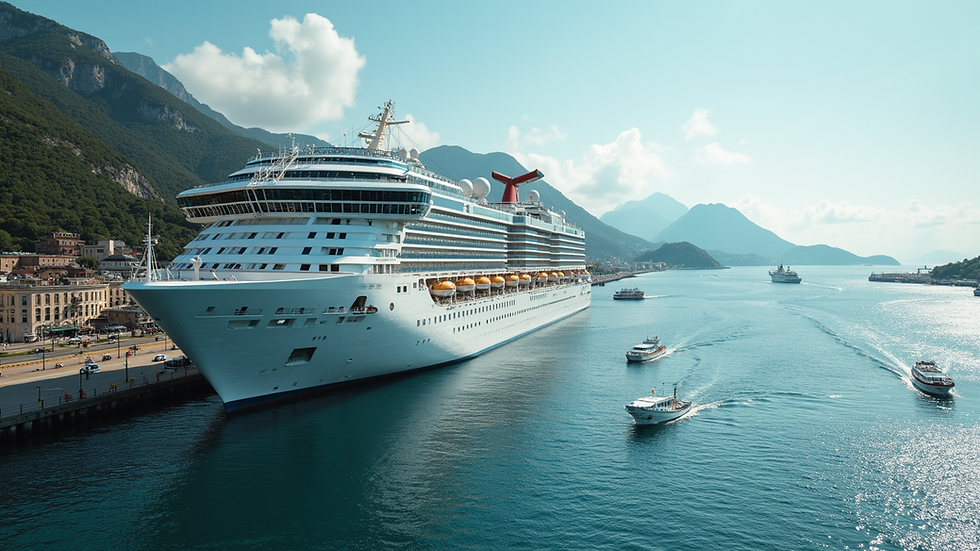The Future of Green Technologies in Maritime
- Elizaa Liza
- May 18
- 4 min read
The maritime industry is on the brink of a significant transformation as it seeks greener solutions to tackle the environmental challenges it faces. The introduction of green technologies not only aims to reduce emissions but also enhances the efficiency, safety, and sustainability of maritime operations. Industry stakeholders are investing heavily in innovative strategies to pave the way for a more sustainable maritime future. In this blog post, we will explore various green technologies driving maritime development forward, the challenges, and the exciting future prospects.
The Role of Green Technologies in Maritime Development
The integration of green technologies in maritime development is a game-changer. From improving energy efficiency to reducing harmful emissions, modern ships are leveraging advanced technologies to promote sustainability. Some of the key innovations include:
Hybrid and Electric Propulsion: Many vessels now combine conventional engines with electric propulsion systems. This hybrid technology allows ships to operate on electric power during port calls, significantly reducing fuel consumption and emissions.
Wind-Assisted Propulsion: Using sails or kites, ships can harness wind energy to propel them forward. This not only saves fuel but also reduces greenhouse gas emissions. An example is the deployment of folding sails on cargo ships that utilize wind power effectively.
Biofuels and Alternative Fuels: The maritime industry is exploring new fuels derived from renewable sources. Biofuels, hydrogen, and ammonia are emerging as viable alternatives to traditional marine fuels, promising a lower carbon footprint.

According to recent studies, adopting these green technologies could lead to a reduction in annual carbon emissions from shipping by up to 30% by 2030. However, transitioning remains a challenge due to the high costs associated with retrofitting older ships and the slow pace of adoption in certain regions.
Understanding Sustainable Coastal Development
As part of the broader marine ecosystem, coastal areas are vulnerable to the impacts of climate change and industrial development. Sustainable coastal development involves planning and managing resources in a way that ensures economic growth while protecting the natural environment. Key components include:
Ecosystem Conservation: Prioritizing the health of coastal ecosystems, such as mangroves and coral reefs, is crucial for maintaining biodiversity and protecting coastal communities from erosion and storms.
Community Engagement: Involving local communities in decision-making processes regarding coastal development is essential. It fosters a sense of ownership and responsibility towards the environment.
Sustainable Practices: Encouraging sustainable fishing practices and reducing waste and pollution are essential for preserving coastal resources.

Implementing these principles in coastal development enhances resilience to climate change while supporting livelihoods and economic development. It is a collaborative effort that requires the participation of governments, businesses, and local communities.
Innovations in Ship Design and Engineering
The maritime industry is witnessing remarkable innovations in ship design aimed at reducing environmental impact. Some notable advancements include:
Energy-efficient Hull Designs: Modern ships are being designed with streamlined hulls that minimize drag and enhance fuel efficiency. Computational fluid dynamics is often used to optimize designs.
Smart Technologies: The integration of IoT (Internet of Things) and AI (Artificial Intelligence) allows ships to monitor fuel consumption and engine performance in real-time, leading to better operational efficiency.
Modular Design: Ships that are easy to modify or upgrade with the latest green technologies will be more adaptable to future regulations and environmental standards. This flexibility can extend the operational life of the vessel and reduce overall costs.
These design innovations not only improve a ship’s environmental performance but also contribute to reduced operational costs for ship owners. A balance must be struck between innovation and economic feasibility to ensure widespread adoption.
Regulatory Frameworks and Industry Initiatives
Governments and international organizations play a critical role in promoting green technologies within the maritime industry. Stricter regulations are being enforced to curb emissions and encourage sustainable practices. Some impactful frameworks include:
International Maritime Organization (IMO) Regulations: The IMO has set ambitious targets for reducing greenhouse gas emissions from shipping by at least 50% by 2050 compared to 2008 levels.
European Green Deal: The European Union is investing in research and development of green maritime technologies and aims to decarbonize its shipping sector by 2050.
Industry Partnerships: Collaborative initiatives among shipbuilders, maritime companies, and technology providers promote the development and adoption of green technologies.

These regulations incentivize shipowners and operators to invest in sustainable alternatives. The maritime sector must continue to adapt to these changes to secure a competitive advantage in the future.
Future Prospects of Green Technologies in Maritime
The future of maritime development is bright, with green technologies paving the way for a more sustainable industry. Several trends point towards a significant shift:
Increased Adoption of Automation: Automated vessels will become more common, improving safety and operational efficiency while reducing fuel consumption.
Carbon-neutral Fuels: Ongoing research is likely to yield advanced fuels produced from renewable energy sources, minimizing the environmental impact of vessels.
Digitalization: The use of digital technologies will streamline operations, reduce waste, and improve compliance with environmental regulations.
Rising Consumer Demand for Sustainability: As awareness around climate change grows, consumers are increasingly favoring businesses committed to sustainability. This trend drives companies in the maritime industry to adopt environmentally friendly practices.
In conclusion, green technologies are set to revolutionize maritime development, making it possible for the industry to thrive without sacrificing the environment. The path to sustainability is filled with opportunities and challenges, but with continued investment and innovation, maritime stakeholders can successfully navigate towards a greener future. For more insights on this topic, visit sustainable maritime development.



Comments